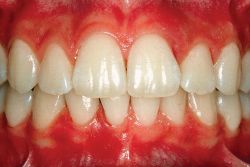Ribbond is a material based on glassfiber.
It is a biocompatible, bondable, colourless and transparent material, which may be combined with any other materials, widely used in dentistry today.
Indications for Ribbond splinting:
Teeth with well-marked bone loss and looseness of categories 1-2.
Retention period following orthodontic treatment.
Immediate tooth replacement in case of front tooth extraction.
Immobilization of a tooth after traumatic dislocation or incomplete dislocation.
Not all patients are candidates for permanent splinting. Consideration is always given, among other things, to clinical aspects of disease, oral cavity condition, presence of dental deposit, gums bleeding, teeth looseness, degree of their displacement.
Working stages:
Thorough removal of dental deposit with ultrasound scaler, polishing of teeth surfaces with pastes.
Selection of shade of the composite material.
Anaesthesia (if necessary).
Preparation of a groove of 1-1.5 mm on the surface of the section for splinting.
Isolation of the working area with a dental dam.
The Ribbond is impregnated with adhesive resin.
Adhesive preparation of teeth surfaces.
The prepared Ribbond is pressed to lingual and palatal surfaces of teeth to be splinted.
Composite resin is placed on the Ribbond surface. The ribbon surface is hardened by means of light-curing.
Mechanical treatment of the splint, its polishing.
The patient is taught hygiene techniques with the help of superflosses and intreproximal brushes
Positive effects of splinting:
Splinting reduced teeth looseness
Splinting reallocates masticatory stress on teeth
Before splinting sanitation of the oral cavity must be performed (removal of dental deposit, teeth treatment)
Fixed partial denture is one of the most modern and prospective methods of teeth restoration which allows for placing a dummy tooth on a fiberglass tape, attached to neighbouring teeth and does not require total preparation of the abutment teeth.

